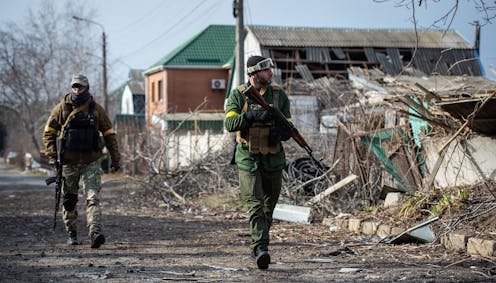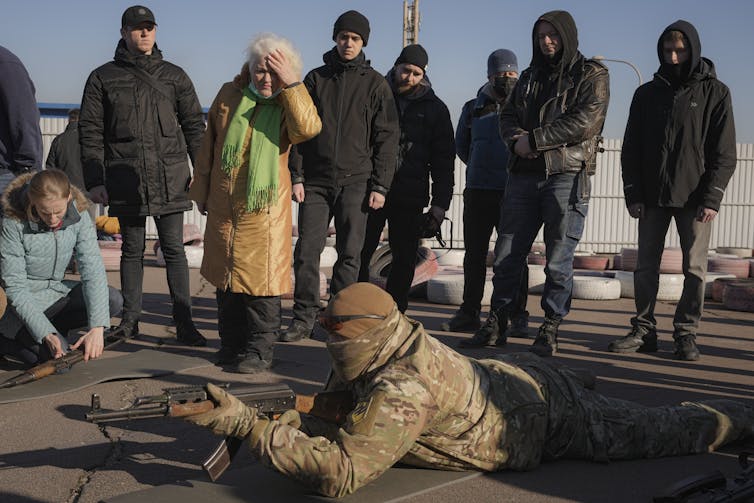US aid to Ukraine: $13.6 billion approved following Russian bombardment marks sharp increase
The money is evenly split between military support and funds for economic, humanitarian and other needs.

The U.S. government has condemned Russia’s war on Ukraine and vowed to make sure Russia faces consequences for its attack. Political scientist Jessica Trisko Darden, author of “Aiding and Abetting: U.S. Foreign Assistance and State Violence,” explains how U.S. assistance to Ukraine is rapidly evolving and what its potential consequences could be.
How much aid has Congress approved?
President Joe Biden signed off on an emergency spending package that included US$13.6 billion in aid for Ukraine on March 11, 2022. Roughly half the money, approved by Congress over the prior two days, is for military purposes. It includes $3.65 billion for weapons transfers and sales to Ukraine and another $3 billion to support more U.S. troops in Europe.
A portion of the funds will support economic warfare against Russia, including efforts to seize the assets of Russian oligarchs, but most of the economic aid will pay for humanitarian relief and disaster assistance. That includes helping refugees and aiding people displaced within Ukraine.
What else is the US doing?
The total amount of aid the U.S. is providing Ukraine exceeds the $13.6 billion in the spending package. On March 12, just one day after Biden signed the spending package, the White House announced another $200 million in immediate military assistance to Ukraine. It includes small arms and anti-tank and anti-aircraft weapons from U.S. defense stocks.
On the ground, the U.S. Agency for International Development, or USAID, is partnering with United Nations agencies to position critical relief supplies throughout Ukraine, including emergency food, surgery and medical kits, thermal blankets and sanitation supplies. Since Russia invaded, USAID has provided $107 million in humanitarian aid.
By the time Russia attacked on Feb. 24, Ukraine had already received most of the weapons from a $200 million military assistance package announced in December 2021.
Immediately after the invasion, Biden announced an additional $350 million in U.S. weapons. That was on top of the U.S.-provided Stinger anti-aircraft weapons and Javelin missile systems being transferred, with American authorization, from Estonia, Latvia and Lithuania to Ukraine.
And the U.S. has reportedly redirected Mi-17 helicopters originally intended for Afghanistan.
What has US assistance to Ukraine looked like since the USSR dissolved?
Because Ukraine had the world’s third-largest nuclear arsenal in 1991, the top U.S. foreign policy objective at first was securing Ukraine’s nuclear weapons.
Through the mid-1990s, the U.S. helped Ukraine dismantle missiles, bombers and other nuclear infrastructure. This denuclearization concluded in 1996 with the transfer of its last nuclear warhead to Russia.
The United States continued to support Ukraine during the Orange Revolution – mass protests in 2004 and 2005 that followed the apparent victory of a pro-Russian presidential candidate widely suspected of fraud. In addition to rhetorical support, the U.S. provided at least $13.8 million to ensure subsequent rounds of the election were free and fair.
U.S. engagement in Ukraine increased dramatically following the Euromaidan Revolution – the wave of protests in late 2013 and 2014 that led to the ouster of then-President Viktor Yanukovych.
Conflict broke out days later when Russia annexed Crimea, a region in southern Ukraine, and began supporting separatist militias in the eastern part of the country. Between the annexation of Crimea and Russia’s invasion, the U.S. had provided more than $2.7 billion in security assistance. Most of this money has funded weapons, training and intelligence cooperation to help Ukraine fight these militias. More than 14,000 Ukrainians were killed between 2014 and 2021.
Ukraine has also received roughly $418 million annually since 2014 from the State Department and USAID. Some of this is officially designated as “nonlethal assistance,” but it includes items such as body armor, helmets, vehicles, heavy engineering equipment and patrol boats that directly support U.S. and Ukrainian security objectives.
In addition, an average of more than $350 million in U.S. humanitarian aid has flowed to Ukraine annually since 2014. This funding provides essential relief items such as blankets and food vouchers, training for health care workers, and structural repairs to homes destroyed by conflict.
What else is going on in terms of military aid for Ukraine?
Military assistance is coming from many additional countries, including $70 million from Australia and about $1.1 billion in military supplies from the European Union.
Russia has threatened to target military aid shipments. When and how military aid to Ukraine will be delivered, given Russian airstrikes on a Ukrainian military base near the Polish border, is unclear. Military analysts emphasize that Ukraine’s strategy relies on urban warfare and a protracted war of attrition.
While much of the pledged military assistance supports this strategy, it’s getting harder to get arms into Ukraine. That’s true for humanitarian aid as well.
Even if this conflict ends soon, what might Ukraine need in the future?
Many countries are pledging military support for Ukraine, but the country will also need help rebuilding after war. Satellite images show the extent of infrastructure damage in some Ukrainian cities. Reconstruction will be complicated by Ukraine’s political challenges, including corruption and deeply rooted political regionalism.
Humanitarian needs will also be stark. Before the invasion, the U.N. estimated that 3.4 million people required humanitarian assistance because of the ongoing conflict in eastern Ukraine. Now that more than 2.8 million Ukrainians have fled the country, providing for these refugees and bringing them home will be a major focus.
Unfortunately, the surge in military assistance and weapons for Ukraine is likely to have significant unintended consequences.
The Ukrainian government has called upon anyone willing to take up arms to do so. More than 25,000 automatic rifles, 10 million bullets, and rocket-propelled grenades and launchers have reportedly been distributed in the capital Kyiv alone. More guns are on the way, from the United States and allies including Canada and Finland.

Pouring weapons into a country at war may seem reasonable, but this influx of arms can trap a country in conflict. According to a recent U.N. report, the proliferation of small arms and light weapons, such as those being distributed in Ukraine, can prolong armed conflict, hinder the implementation of peace agreements and endanger peacekeepers and local civilians. In short, the weapons being sent to help Ukraine today might make the country more violent in the years to come.
There is also a risk that once the current crisis passes, light weapons could end up elsewhere in Europe or fall under the control of militias operating in Ukraine, including the far-right Azov battalion. To reduce that risk, a costly weapons buyback program may be necessary, although the success of such programs remains hotly debated.
This is an updated version of an article originally published on March 2, 2022.
Jessica Trisko Darden is a non-resident fellow with the Eurasia Group Foundation and Director of the Security and Foreign Policy Initiative at William & Mary's Global Research Institute.
Read These Next
As millions of Americans face a steep rise in health insurance costs, lawmakers continue a century-l
US health care policy will remain fractured until lawmakers address the core question of who is responsible…
RFK Jr. wants to scrutinize the vaccine schedule – but its safety record is already decades long
Federal officials are questioning the safety of the vaccine series children receive. Here’s the story…
Understanding climate change in America: Skepticism, dogmatism and personal experience
Real skeptics study the evidence and ask questions, rather than taking political dogma on faith. Experiencing…






